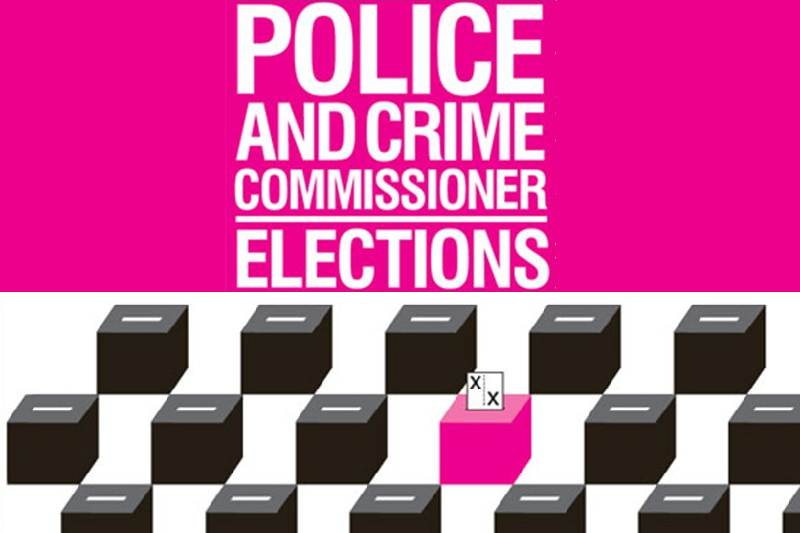The rescheduled police and crime commissioner (PCC) elections in England and Wales are set to take place in just under a month’s time, on Thursday 6 May 2021. Policing Insight is keeping a close eye on the various contests, with a dedicated channel and a page for each police area being contested. This latest article takes a look at the confirmed candidate lists that form the content of the ballot papers now being printed.
PCC Election 2021: Click a police area to view candidates and results from previous elections
Avon & Somerset | Bedfordshire| Cambridgeshire | Cheshire | Cleveland | Cumbria | Derbyshire | Devon & Cornwall | Dorset | Durham | Dyfed-Powys | Essex | Gloucestershire | Gwent | Hampshire | Hertfordshire | Humberside | Kent | Lancashire | Leicestershire | Lincolnshire | Merseyside | Norfolk | North Wales | North Yorkshire | Northamptonshire | Northumbria | Nottinghamshire | South Wales | South Yorkshire | Staffordshire | Suffolk | Surrey | Sussex | Thames Valley | Warwickshire | West Mercia | West Midlands | Wiltshire
With 39 to be elected – 35 police and crime commissioners (PCCs), and four police, fire and crime commissioners (PFCCs) – there are 166 confirmed candidates: 39 Conservative, 39 Labour, 39 Liberal Democrat, 11 Reform UK, seven Green, four Plaid Cymru, two English Democrat, one Gwlad, one Propel, one Hampshire Independent, one Lincolnshire Independent, one Zero Tolerance Policing ex-Chief, one candidate for the We Matter Party, and 19 Independents (including one Independent PCC previously elected as an Independent, and one Independent PCC previously elected as a Conservative).
In 2016, there were a total of 188 candidates: 40 Conservative, 40 Labour, 34 UKIP, 30 Liberal Democrat, 25 Independent, seven Green, four Plaid Cymru, four English Democrat, three Zero Tolerance Policing, and one Lincolnshire Independent. Note, though, that these numbers from 2016 included PCC elections in West Yorkshire, which this year will elect a Mayor (with policing oversight responsibilities) rather than a PCC.
Here are details of the 166 candidates for the 2021 PCC elections, split by political party and by force area, and with M or F indicating whether the candidate is male or female. An M or F accompanied by asterisks (*M* or *F*) indicates that the current PCC is running for re-election; just 22 of the existing 39 PCCs are, in the end, standing again.
PCC Elections 2021: Confirmed candidate numbers by party and gender
Table legend
F – Female *F* – Female incumbent PCC for re-election
M Male *M* – Male incumbent PCC for re-election
G – Greens
PC – Plaid Cymru
ED – English Democrats
I – Independent & Other
R – Reform UK
| Force area | Political parties |
Number of candidates and by gender |
|||||||||
| C | L | LD | G | ED | R | PC | I | TOTAL | Female | Male | |
| Avon & Somerset |
M | M | F | F | M | 5 | 2 | 3 | |||
| Bedfordshire | M | M | M | M | M | 5 | 0 | 5 | |||
| Cambridgeshire | M | F | M | F | 4 | 2 | 2 | ||||
| Cheshire | M | *M* | F | M | 4 | 1 | 3 | ||||
| Cleveland | M | M | M | M | 4 | 0 | 4 | ||||
| Cumbria | *M* | F | F | 3 | 2 | 1 | |||||
| Derbyshire | F | *M* | M | M | 4 | 1 | 3 | ||||
| Devon & Cornwall |
*F* | M | M | M | 4 | 1 | 3 | ||||
| Dorset | M | M | M | F | M | 5 | 1 | 4 | |||
| Durham | M | F | F | 3 | 2 | 1 | |||||
| Dyfed-Powys | M | F | M | *M* | 4 | 1 | 3 | ||||
| Essex | *M* | M | M | M | 4 | 0 | 4 | ||||
| Gloucestershire | M | M | M | *M* M |
5 | 0 | 5 | ||||
| Gwent | F | *M* | M | F | M M |
6 | 2 | 4 | |||
| Hampshire | F | M | M | M | 4 | 1 | 3 | ||||
| Hertfordshire | *M* | M | M | 3 | 0 | 3 | |||||
| Humberside | M | *M* | M | 3 | 0 | 3 | |||||
| Kent | *M* | F | M | 3 | 1 | 2 | |||||
| Lancashire | M | M | M | M | 4 | 0 | 4 | ||||
| Leicestershire | M | M | M | 3 | 0 | 3 | |||||
| Lincolnshire | *M* | F | M | M M |
5 | 1 | 4 | ||||
| Merseyside | M | F | M | M | 4 | 1 | 3 | ||||
| Norfolk | M | M | M | M | M | 5 | 0 | 5 | |||
| North Wales | F | M | F | F | M | 5 | 3 | 2 | |||
| North Yorkshire | M | F | M | M | 4 | 1 | 3 | ||||
| Northamptonshire | *M* | F | F | M | 4 | 2 | 2 | ||||
| Northumbria | M | *F* | M | M | 4 | 1 | 3 | ||||
| Nottinghamshire | F | *M* | M | 3 | 1 | 2 | |||||
| South Wales | M | *M* | M | F | F M |
6 | 2 | 4 | |||
| South Yorkshire | M | *M* | M | 3 | 0 | 3 | |||||
| Staffordshire | M | M | M | M | F | 5 | 1 | 4 | |||
| Suffolk | *M* | F | M | M | 4 | 1 | 3 | ||||
| Surrey | F | M | M | *M* M |
5 | 1 | 4 | ||||
| Sussex | *F* | M | M | F | M | 5 | 2 | 3 | |||
| Thames Valley | M | F | M | M | 4 | 1 | 3 | ||||
| Warwickshire | *M* | M | M | M | 4 | 0 | 4 | ||||
| West Mercia | *M* | M | F | M | 4 | 1 | 3 | ||||
| West Midlands | M | M | M | M | F M |
6 | 1 | 5 | |||
| Wiltshire | M | M | F | M | M | M | 6 | 1 | 5 | ||
| TOTALS | 39 | 39 | 39 | 7 | 2 | 11 | 4 | 25 | 166 | 38 | 128 |
| Female | 8 | 12 | 8 | 3 | 0 | 1 | 3 | 3 | 38 | ||
| Male | 31 | 27 | 31 | 4 | 2 | 10 | 1 | 22 | 128 | ||
It’s quite remarkable just how strongly this ‘long list’ of candidates is male-dominated. Under a quarter of this year’s PCC (and PFCC) candidates are female. Compare that with the House of Commons, where women account for over one third (34%) of MPs; and with local government, where women account for around the same proportion (35%) of councillors.
Take a look, also, at the gender balance of candidates by political party. Of the three parties fielding candidates in all PCC elections, Labour does ‘best’ with around one third of its candidates being female, while the Conservatives and Liberal Democrats have both selected women to represent them in under a quarter of their PCC campaigns. Of the other parties, three of Plaid Cymru’s four candidates (75%), three of the Green Party’s seven candidates (42.8%), one of Reform UK’s 11 candidates (9.1%) and none of the English Democrats’ candidates are female.
Over the coming few days and weeks, and certainly well before the elections on 6 May, I’ll look a little further at both candidates and battlegrounds. For example, how about the ethnic diversity of candidates – representative of society as a whole? Spoiler: almost certainly not, though Bedfordshire seeks to correct the balance.
And where are the election results likely to be the tightest, or potentially the most surprising or hard fought? Spoiler: Bedfordshire again, plus worth keeping an eye on Surrey.
Just three weeks to go before the vote!
NOTE: This article was updated on Thursday 15th April.
Related articles
 All change: Policing governance is a hot topic once again
All change: Policing governance is a hot topic once again
The PCC elections are set to take place in May. Deloitte’s fourth report into police and crime commissioners is also due out the same month and will enable new and returning PCCs to optimise their role at a time of considerable change in policing. Deloitte’s Frances Lysak explains the focus of this latest report.
 Learning the lessons: What previous PCC elections can tell us about this year’s contest
Learning the lessons: What previous PCC elections can tell us about this year’s contest
This May, in England and Wales, the public will go to the polls to elect their local police and crime commissioner. Professor Peter Joyce and Dr Wendy Laverick examine the lessons to be learnt from the previous two elections in 2012 and 2016 and what prospective candidates are likely to focus on in 2020.
 There’s (another) election on the horizon: The PCC race for 2020
There’s (another) election on the horizon: The PCC race for 2020
While the focus of attention is on the upcoming general election, candidates for the next round of PCC elections are also becoming clear. Nina Champion, Director of the Criminal Justice Alliance, and Phil Bowen, Director of the Centre for Justice Innovation, look at how the race could affect criminal justice policy.



